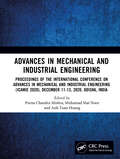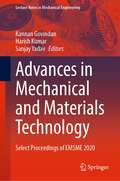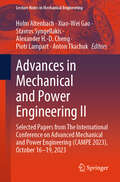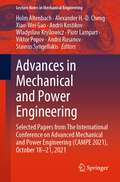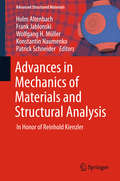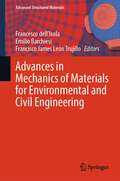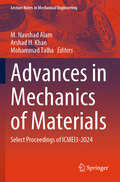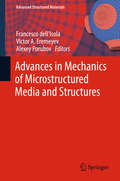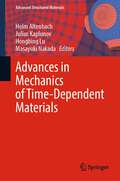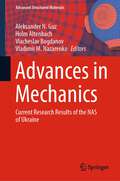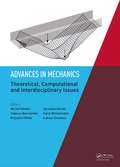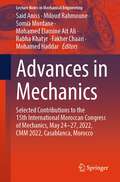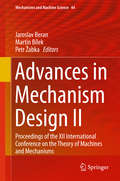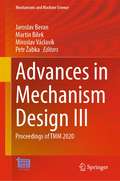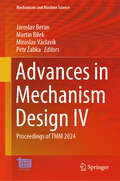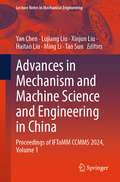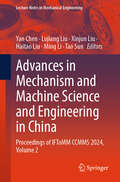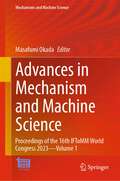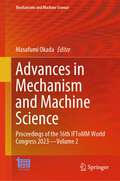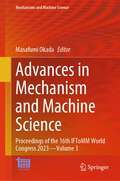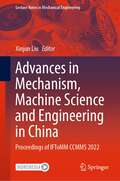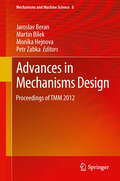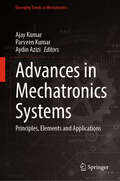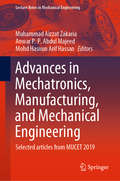- Table View
- List View
Advances in Mechanical and Industrial Engineering: Proceedings of the International Conference on Advances in Mechanical and Industrial Engineering (ICAMIE 2020), December 11-13, 2020, Odisha, India
by Purna Chandra Mishra Muhamad Mat Noor Anh Tuan HoangThe International Conference on ADVANCES IN MECHANICAL AND INDUSTRIAL ENGINEERING (ICAMIE –2020) aims to solidify knowledge of sister branches of research on Mechanical Engineering applied to Industry, Health Sectors, Energy Sector, Agricultural Sector etc. Mechanical Engineering is a core branch of Engineering with its own peculiarities and very diverse areas of action. (ICAMIE –2020) will widen the scope of bringing together innovators, researchers and industries under a common goal – creating, evaluating, implementing and benefiting from innovations in the areas of engineering applications It will thus support innovative projects and bring benefits to all involved participants. Participants from Universities, Institutes, Associations, Companies, Consultancies, R&Ds etc. from India and abroad will be invited. The aim of (ICAMIE –2020) is to be one of the most influential channels for transferring innovative ideas from academia to industry thereby these ideas may start to generate consultancy, projects and collaborations. The novel idea to conduct this type of conference is to discuss social and industrial problems and try to find a way to resolve their solutions by advanced methods and methodologies like soft computing techniques, Multi-criteria decision making algorithms, Internet of Things, technologies, Artificial intelligence, Robotics etc. (ICAMIE –2020) will be successful being the multidisciplinary conference of its first kind and aims to be one of the most influential channels transferring innovative ideas from academia to industry thereby these ideas may start to generate consultancy, projects and collaborations.
Advances in Mechanical and Materials Technology: Select Proceedings of EMSME 2020 (Lecture Notes in Mechanical Engineering)
by Kannan Govindan Harish Kumar Sanjay YadavThis book presents select papers from the International Conference on Energy, Material Sciences and Mechanical Engineering (EMSME) - 2020. The book covers the three core areas of energy, material sciences and mechanical engineering. The topics covered include non-conventional energy resources, energy harvesting, polymers, composites, 2D materials, systems engineering, materials engineering, micro-machining, renewable energy, industrial engineering and additive manufacturing. This book will be useful to researchers and professionals working in the areas of mechanical and industrial engineering, materials applications, and energy technology.
Advances in Mechanical and Power Engineering II: Selected Papers from The International Conference on Advanced Mechanical and Power Engineering (CAMPE 2023), October 16-19, 2023 (Lecture Notes in Mechanical Engineering)
by Alexander H.-D. Cheng Holm Altenbach Stavros Syngellakis Xiao-Wei Gao Piotr Lampart Anton TkachukThis book covers theoretical and experimental findings at the interface between fluid mechanics, heat transfer and energy technologies. It reports on the development and improvement of numerical methods and intelligent technologies for a wide range of applications in mechanical, power and materials engineering. It reports on solutions to modern fluid mechanics and heat transfer problems, on strategies for studying and improving the dynamics and durability of power equipment, discussing important issues relating to energy saving and environmental safety. Gathering selected contributions to the XV International Conference on Advanced Mechanical and Power Engineering (CAMPE 2023), held online on October 16-19, 2023, from Kharkiv, Ukraine, this book offers a timely update and extensive information for both researchers and professionals in the field of mechanical and power engineering.
Advances in Mechanical and Power Engineering: Selected Papers from The International Conference on Advanced Mechanical and Power Engineering (CAMPE 2021), October 18-21, 2021 (Lecture Notes in Mechanical Engineering)
by Alexander H.-D. Cheng Holm Altenbach Stavros Syngellakis Xiao-Wei Gao Аndrii Kostikov Wladyslaw Kryllowicz Piotr Lampart Viktor Popov Andrii RusanovThis book covers theoretical and experimental findings at the interface between fluid mechanics, heat transfer and energy technologies. It reports on the development and improvement of numerical methods and intelligent technologies for a wide range of applications in mechanical, power and materials engineering. It reports on solutions to modern fluid mechanics and heat transfer problems, on strategies for studying and improving the dynamics and durability of power equipment, discussing important issues relating to energy saving and environmental safety. Gathering selected contributions to the XIV International Conference on Advanced Mechanical and Power Engineering (CAMPE 2021), held online on October 18-21, 2021, from Kharkiv, Ukraine, this book offers a timely update and extensive information for both researchers and professionals in the field of mechanical and power engineering.
Advances in Mechanics of High-Temperature Materials (Advanced Structured Materials #117)
by Konstantin Naumenko Manja KrügerThis book presents a collection of contributions on advanced approaches to the mechanics of materials and mechanics of structures for high-temperature applications, such as power plant components, engines and turbochargers. The contributions highlight advanced constitutive models for high-temperature materials, as well as new approaches to the efficient modeling and analysis of engineering structures operating in high-temperature environments.
Advances in Mechanics of Materials and Structural Analysis: In Honor of Reinhold Kienzler (Advanced Structured Materials #80)
by Wolfgang H. Müller Holm Altenbach Konstantin Naumenko Frank Jablonski Patrick SchneiderThis book presents a collection of contributions on the advanced mechanics of materials and mechanics of structures approaches, written in honor of Professor Kienzler. It covers various topics related to constitutive models for advanced materials, recent developments in mechanics of configuration forces, as well as new approaches to the efficient modeling and analysis of engineering structures.
Advances in Mechanics of Materials for Environmental and Civil Engineering (Advanced Structured Materials #197)
by Francesco Dell’Isola Emilio Barchiesi Francisco James León TrujilloThis book deals with both mathematical modeling and experimental studies related to systems relevant for various civil engineering fields. The book explores the intriguing effects of phenomena occurring at lower length scales on the behavior at higher scales, as the influence of polypropylene macro-fiber thickness in fiber-reinforced concrete mechanical strengths. Generally speaking, the book addresses several key topics, including artificial intelligence applied to the control and monitoring of construction site personnel, finite element models for endplate beam-to-column connections under various load conditions, random functionally graded micropolar beams, and many others. The book explores the design and study of microstructures aimed at increasing the toughness and durability of novel materials in building and construction, based also on the re-utilization of residues and wastes of metallurgical industry produces. In conclusion, the book highlights innovative approaches to various fields of civil engineering, including microstructures for enhanced mechanical properties, offering insights into design strategies.
Advances in Mechanics of Materials: Select Proceedings of ICMEI3-2024 (Lecture Notes in Mechanical Engineering)
by Mohammad Talha M. Naushad Alam Arshad H. KhanThis book presents select peer-reviewed papers from the First International Conference on Mechanical Engineering (ICMEI3 2024). It covers recent research on various topics such as mechanics of functional materials and smart structures, composite and sandwich materials, impact mechanics, fracture and damage in different materials, mechanics of advanced and soft materials, material characterization, solid-fluid Interaction, tribology, condition monitoring and many others. It is a valuable reference for academics, researchers and civil and mechanical engineers working in areas of structural and material engineering and mechanics.
Advances in Mechanics of Microstructured Media and Structures (Advanced Structured Materials #87)
by Victor A. Eremeyev Francesco Dell’Isola Alexey PorubovThis book is an homage to the pioneering works of E. Aero and G. Maugin in the area of analytical description of generalized continua. It presents a collection of contributions on micropolar, micromorphic and strain gradient media, media with internal variables, metamaterials, beam lattices, liquid crystals, and others. The main focus is on wave propagation, stability problems, homogenization, and relations between discrete and continuous models.
Advances in Mechanics of Time-Dependent Materials (Advanced Structured Materials #188)
by Hongbing Lu Holm Altenbach Masayuki Nakada Julius KaplunovThis book presents current trends in Mechanics of Time Dependent Materials. It covers a number of cutting-edge themes, such as characterization of linear and nonlinear mechanical behavior of viscoelastic materials and their composites, taking into consideration large deformations, low, moderate and large strain rates, as well as failure and fracture phenomena. The contributions are inspired by advanced applications in modern technologies, such as injection molding and extrusion.
Advances in Mechanics: Current Research Results of the NAS of Ukraine (Advanced Structured Materials #191)
by Holm Altenbach Aleksander N. Guz Vladimir M. Nazarenko Viacheslav BogdanovThis book covers research from modern directions in solid mechanics, in particular, in the fields of mechanics of composite materials, fracture mechanics, strength of materials and structures, thermo-viscoelasticity and plasticity, mechanics of shell structures, contact mechanics, theory of wave propagation, dynamics of mechanical and hydromechanical systems. The book presents some new results in the main research directions in mechanics on which the institutions of the National Academy of Sciences of Ukraine are focused. In addition to these studies, the results of joint scientific projects of the academic institutions with universities and research institutions of Ukraine are presented. The work is dedicated to the 145th anniversary of Stepan Prokopovich Timoshenko, the world-famous scientist in the field of mechanics, the founder of the Institute of Mechanics of the National Academy of Sciences of Ukraine, one of the founders of the National Academy of Sciences of Ukraine and academic teacher with world-wide reputation with great influence on engineering education.
Advances in Mechanics: Proceedings of the 3rd Polish Congress of Mechanics (PCM) and 21st International Conference on Computer Methods in Mechanics (CMM), Gdansk, Poland, 8-11 September 2015
by Tadeusz Burczyński Krzysztof Wilde Karol Winkelmann Michal Kleiber JJarosław Górski Łukasz SmakoszAdvances in Mechanics: Theoretical, Computational and Interdisciplinary Issues covers the domain of theoretical, experimental and computational mechanics as well as interdisciplinary issues, such as industrial applications. Special attention is paid to the theoretical background and practical applications of computational mechanics.This volume
Advances in Mechanics: Selected Contributions to the 15th International Moroccan Congress of Mechanics, May 24-27, 2022, CMM 2022, Casablanca, Morocco (Lecture Notes in Mechanical Engineering)
by Fakher Chaari Mohamed Haddar Said Aniss Miloud Rahmoune Somia Mordane Mohamed Elamine Ait Ali Rabha KhatyrThis book reports on innovative research in solid and fluid mechanics, and thermal engineering, giving a special emphasis on methods, modeling, and simulation tools for analyzing material behavior and energy systems. It gathers the best papers presented at 15th International Moroccan Congress of Mechanics "Congrès de Mécanique", CMM 2022, held on May 24-27, 2022, in Casablanca, Morocco, and organized by the Moroccan Society of Mechanics (SMSM) and the Faculty of Science Ain Chock of the University of Hassan II, Casablanca, Morocco. With a good balance of theory and practice, the book offers a timely snapshot of current advances in mechanics, and a source of inspiration for future research and international collaborations.
Advances in Mechanism Design II: Proceedings of the XII International Conference on the Theory of Machines and Mechanisms (Mechanisms and Machine Science #44)
by Jaroslav Beran Martin Bílek Petr ŽabkaThis book presents the most recent advances in the research of machines and mechanisms. It collects 54 reviewed papers presented at the XII International Conference on the Theory of Machines and mechanisms (TMM 2016) held in Liberec, Czech Republic, September 6-8, 2016. This volume offers an international selection of the most important new results and developments, grouped in six different parts, representing a well-balanced overview, and spanning the general theory of machines and mechanisms, through analysis and synthesis of planar and spatial mechanisms, linkages and cams, robots and manipulators, dynamics of machines and mechanisms, rotor dynamics, computational mechanics, vibration and noise in machines, optimization of mechanisms and machines, mechanisms of textile machines, mechatronics to the control and monitoring systems of machines. This conference is traditionally organised every four year under the auspices of the international organisation IFToMM and the Czech Society for Mechanics.
Advances in Mechanism Design III: Proceedings of TMM 2020 (Mechanisms and Machine Science #85)
by Jaroslav Beran Martin Bílek Petr Žabka Miroslav VáclavíkThis book presents the latest research advances relating to machines and mechanisms. Featuring papers from the XIII International Conference on the Theory of Machines and Mechanisms (TMM 2020), held in Liberec, Czech Republic, on September 7-9, 2021, it includes a selection of the most important new results and developments. The book is divided into five parts, representing a well-balanced overview, and spanning the general theory of machines and mechanisms, through analysis and synthesis of planar and spatial mechanisms, linkages and cams, robots and manipulators, dynamics of machines and mechanisms, rotor dynamics, computational mechanics, vibration and noise in machines, optimization of mechanisms and machines, mechanisms of textile machines, mechatronics and control and monitoring systems of machines. This conference is traditionally held every four years under the auspices of the international organisation IFToMM and the Czech Society for Mechanics.
Advances in Mechanism Design IV: Proceedings of TMM 2024 (Mechanisms and Machine Science #171)
by Jaroslav Beran Martin Bílek Petr Žabka Miroslav VáclavíkThis book presents the latest research advances relating to machines and mechanisms. Featuring papers from the XIV International Conference on the Theory of Machines and Mechanisms (TMM), held in Liberec, Czech Republic, on September 3–5, 2024, it includes a selection of the most important new results and developments. The book is divided into five parts, representing a well-balanced overview, and spanning the general theory of machines and mechanisms, through analysis and synthesis of planar and spatial mechanisms, linkages and cams, robots and manipulators, dynamics of machines and mechanisms, rotor dynamics, computational mechanics, vibration and noise in machines, optimization of mechanisms and machines, mechanisms of textile machines, mechatronics and control, and monitoring systems of machines. This conference is traditionally held every four years under the auspices of the international organisation IFToMM and the Czech Society for Mechanics.
Advances in Mechanism and Machine Science and Engineering in China: Proceedings of IFToMM CCMMS 2024, Volume 1 (Lecture Notes in Mechanical Engineering)
by Tao Sun Ming Li Yan Chen Haitao Liu Xinjun Liu Lujiang LiuThis book collects selected papers of the 24th IFToMM China International Conference on Mechanism and Machine Science and Engineering (CCMMS 2024). CCMMS was initiated in 1982, and it is the most important forum held in China for exchange of research ideas, presentation of technical and scientific achievements, and discussion of future directions in the field of mechanism and machine science. The topics include theoretical and computational kinematics, dynamics and control, engines and transmission systems, parallel/hybrid mechanisms and industrial robotics, compliant mechanisms, origami mechanisms and soft robotics, metamorphic mechanisms and robotics, deployable structures and mechanisms, aerospace mechanisms and environmental effects, micro/nano mechanisms and robotics, biologically inspired mechanisms and robotics, medical and rehabilitation robotics, mobile robotics and heavy non-road mobile machines, history of mechanisms, machines and robotics, and engineering education on mechanisms. This book provides a state-of-the-art overview of current advances in mechanism and machine science in China. The inspiring ideas presented in the papers will enlighten the trend in academic research and industrial application. The potential readers include academic researchers and industrial professionals in the field of mechanism and machine science.
Advances in Mechanism and Machine Science and Engineering in China: Proceedings of IFToMM CCMMS 2024, Volume 2 (Lecture Notes in Mechanical Engineering)
by Tao Sun Ming Li Yan Chen Haitao Liu Xinjun Liu Lujiang LiuThis book collects selected papers of the 24th IFToMM China International Conference on Mechanism and Machine Science and Engineering (CCMMS 2024). CCMMS was initiated in 1982, and it is the most important forum held in China for exchange of research ideas, presentation of technical and scientific achievements, and discussion of future directions in the field of mechanism and machine science. The topics include theoretical and computational kinematics, dynamics and control, engines and transmission systems, parallel/hybrid mechanisms and industrial robotics, compliant mechanisms, origami mechanisms and soft robotics, metamorphic mechanisms and robotics, deployable structures and mechanisms, aerospace mechanisms and environmental effects, micro/nano mechanisms and robotics, biologically inspired mechanisms and robotics, medical and rehabilitation robotics, mobile robotics and heavy non-road mobile machines, history of mechanisms, machines and robotics, and engineering education on mechanisms. This book provides a state-of-the-art overview of current advances in mechanism and machine science in China. The inspiring ideas presented in the papers will enlighten the trend in academic research and industrial application. The potential readers include academic researchers and industrial professionals in the field of mechanism and machine science.
Advances in Mechanism and Machine Science: Proceedings of the 16th IFToMM World Congress 2023—Volume 1 (Mechanisms and Machine Science #147)
by Masafumi OkadaThis book gathers the proceedings of the 16th IFToMM World Congress, which was held in Tokyo, Japan, on November 5–10, 2023. Having been organized every four years since 1965, the Congress represents the world’s largest scientific event on mechanism and machine science (MMS). The contributions cover an extremely diverse range of topics, including biomechanical engineering, computational kinematics, design methodologies, dynamics of machinery, multibody dynamics, gearing and transmissions, history of MMS, linkage and mechanical controls, robotics and mechatronics, micro-mechanisms, reliability of machines and mechanisms, rotor dynamics, standardization of terminology, sustainable energy systems, transportation machinery, tribology and vibration. Selected by means of a rigorous international peer-review process, they highlight numerous exciting advances and ideas that will spur novel research directions and foster new multidisciplinary collaborations.
Advances in Mechanism and Machine Science: Proceedings of the 16th IFToMM World Congress 2023—Volume 2 (Mechanisms and Machine Science #148)
by Masafumi OkadaThis book gathers the proceedings of the 16th IFToMM World Congress, which was held in Tokyo, Japan, on November 5–10, 2023. Having been organized every four years since 1965, the Congress represents the world’s largest scientific event on mechanism and machine science (MMS). The contributions cover an extremely diverse range of topics, including biomechanical engineering, computational kinematics, design methodologies, dynamics of machinery, multibody dynamics, gearing and transmissions, history of MMS, linkage and mechanical controls, robotics and mechatronics, micro-mechanisms, reliability of machines and mechanisms, rotor dynamics, standardization of terminology, sustainable energy systems, transportation machinery, tribology and vibration. Selected by means of a rigorous international peer-review process, they highlight numerous exciting advances and ideas that will spur novel research directions and foster new multidisciplinary collaborations.
Advances in Mechanism and Machine Science: Proceedings of the 16th IFToMM World Congress 2023—Volume 3 (Mechanisms and Machine Science #149)
by Masafumi OkadaThis book gathers the proceedings of the 16th IFToMM World Congress, which was held in Tokyo, Japan, on November 5–10, 2023. Having been organized every four years since 1965, the Congress represents the world’s largest scientific event on mechanism and machine science (MMS). The contributions cover an extremely diverse range of topics, including biomechanical engineering, computational kinematics, design methodologies, dynamics of machinery, multibody dynamics, gearing and transmissions, history of MMS, linkage and mechanical controls, robotics and mechatronics, micro-mechanisms, reliability of machines and mechanisms, rotor dynamics, standardization of terminology, sustainable energy systems, transportation machinery, tribology and vibration. Selected by means of a rigorous international peer-review process, they highlight numerous exciting advances and ideas that will spur novel research directions and foster new multidisciplinary collaborations.
Advances in Mechanism, Machine Science and Engineering in China: Proceedings of IFToMM CCMMS 2022 (Lecture Notes in Mechanical Engineering)
by Xinjun LiuThis book presents the conference proceedings of the 23rd IFToMM China International Conference on Mechanism and Machine Science & Engineering (IFToMM CCMMS 2022). CCMMS was initiated in 1982, and it is the most important forum held in China for the exchange of research ideas, presentation of technical and scientific achievements, and discussion of future directions in the field of mechanism and machine science. The topics include parallel/hybrid mechanism synthesis and analysis, theoretical & computational kinematics, compliant mechanisms and micro/nano-mechanisms, reconfigurable and metamorphic mechanisms, space structures, mechanisms and materials, structure adaptation in space environment and ground testing, large-scale membrane deployable structures, construction and application of super-scale space systems, cams, gears and combining mechanisms, fluid power mechatronics drivetrain, mechanical design theory and methods, dynamics and vibration control, mechatronics, biologically inspired mechanisms and robotics, medical & rehabilitation robotics, mobile robotics, soft robotics, heavy non-road mobile machine, robot applications, engineering education on mechanisms, machines, and robotics. This book provides a state-of-the-art overview of current advances in mechanism and machine science in China. The inspiring ideas presented in the papers enlighten academic research and industrial application. The potential readers include academic researchers and industrial professionals in mechanism and machine science.
Advances in Mechanisms Design: Proceedings of TMM 2012 (Mechanisms and Machine Science #8)
by Jaroslav Beran Martin Bílek Monika Hejnova Petr ZabkaThe International Conference on the Theory of Machines and Mechanisms is organized every four years, under the auspices of the International Federation for the Promotion of Mechanism and Machine Science (IFToMM) and the Czech Society for Mechanics. This eleventh edition of the conference took place at the Technical University of Liberec, Czech Republic, 4-6 September 2012. This volume offers an international selection of the most important new results and developments, in 73 papers, grouped in seven different parts, representing a well-balanced overview, and spanning the general theory of machines and mechanisms, through analysis and synthesis of planar and spatial mechanisms, dynamics of machines and mechanisms, linkages and cams, computational mechanics, rotor dynamics, biomechanics, mechatronics, vibration and noise in machines, optimization of mechanisms and machines, control and monitoring systems of machines, accuracy and reliability of machines and mechanisms, robots and manipulators to the mechanisms of textile machines.
Advances in Mechatronics Systems: Principles, Elements and Applications (Emerging Trends in Mechatronics)
by Ajay Kumar Aydin Azizi Parveen KumarThis book consists of eleven chapters that covers all aspects of mechatronics systems from basics to advanced. This book is an edited compilation of original research and applications backed with experimental, numerical and theoretical data on mechatronics systems, suitably categorized into sections of closely related topics, contributed by researchers, academics, scientists, industrialists and professionals from the field on various aspects of mechatronics. Therefore, it will provide logical, technical as well as analytical solutions and ideas to complex problems faced by researchers in the field of mechatronics. The academicians and students will get a comprehensive update on the state-of-the-art in this area and ample ideas for further research and innovation in mechatronics.
Advances in Mechatronics, Manufacturing, and Mechanical Engineering: Selected articles from MUCET 2019 (Lecture Notes in Mechanical Engineering)
by Mohd Hasnun Arif Hassan Anwar P. P. Abdul Majeed Muhammad Aizzat ZakariaThis book highlights selected papers from the Mechanical Engineering track, with a focus on mechatronics and manufacturing, presented at the “Malaysian Technical Universities Conference on Engineering and Technology” (MUCET 2019). The conference brings together researchers and professionals in the fields of engineering, research and technology, providing a platform for future collaborations and the exchange of ideas.
